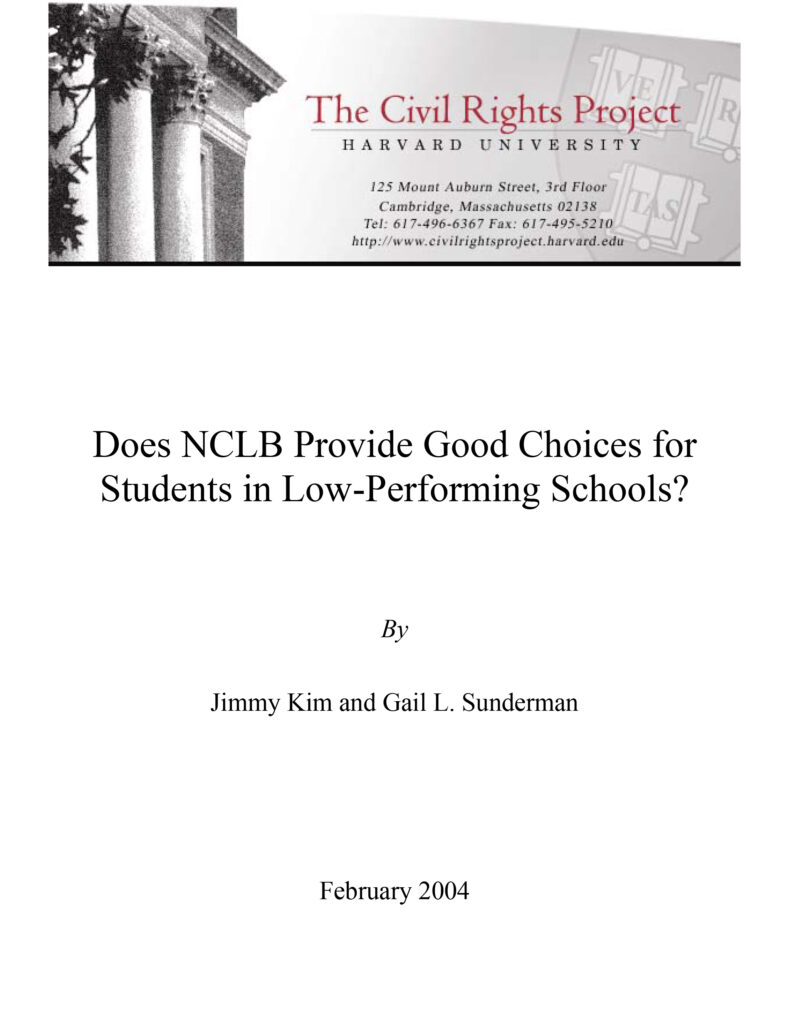Executive Summary
Expanded schooling options for disadvantaged children is one of the four major principles of the No Child Left Behind Act (NCLB), representing the theory that competition will produce better educational opportunities for disadvantaged students and improve the performance of low-performing schools. Under NCLB, school choice is the first in a series of sanctions that are applied to schools failing to meet a state’s adequate yearly progress (AYP) goals, which are based on students’ reading and math scores for a given year. These low performing schools are then required to offer their students the option to transfer to another public school that did make adequate yearly progress. With any new reform, it is important to understand the policy mechanisms that have been put in to achieve its stated goal.
To understand whether the NCLB transfer policy improved educational options for low-income and minority students, we examined the implementation of public school choice in ten urban districts— Mesa Public Schools and Washington Elementary District Schools, AZ, Fresno Unified School District and Los Angeles Unified School District, CA, Chicago Public Schools, IL, Buffalo Public Schools and New York City Public Schools, NY, Richmond Public Schools, VA, and Atlanta Public Schools and DeKalb County Schools, GA. This geographically, politically, and demographically diverse sample of districts provides a range of local contexts for studying the implementation of the NCLB transfer options.
This report is organized into three major sections. First, we examine the number of students who requested transfers and were offered the opportunity to move to a different school. Second, we explore the actual schooling options available to students attending schools that were required to offer choice. Third, we analyze the constraints districts faced in complying with the regulations governing the NCLB transfer option. Our analyses reveal three broad findings:
The NCLB transfer option was not widely used.
- In each of the ten districts in our study, fewer than 3% of eligible students requested to transfer to a different school.
- In two of the nation’s largest school districts—Chicago and New York—thousands of students were eligible to transfer schools. In particular, 1.9% of eligible students requested transfers in Chicago, and only 2.3% of eligible students requested transfers in New York.
- No district in our study was able to approve all transfer requests. In general, districts with fewer transfer requests were more likely to grant transfers.
- Parents whose transfer requests were approved often chose to keep their children in the neighborhood schools. For example, in Fresno, only 62 of the 111 students (56%) whose transfer requests were approved actually moved out of their neighborhood school.
In the districts we studied, the NCLB transfer provisions failed to provide economically
disadvantaged students with opportunities to move to schools with high achievement levels
and low poverty rates.
- Schools that were chosen to accept transfers did not have substantially higher achievement levels or lower poverty rates, on average, than schools required to offer the NCLB transfer option. As a result, many students who transferred went from one school with low achievement levels to another with similarly low achievement levels.
Although urban districts have a disproportionately large number of schools required to
offer transfers, the federal regulations governing choice make it difficult for these districts
to create workable and effective transfer policies.
- A disproportionate number of schools offering transfers are located in urban school districts. These requirements impose major financial and administrative burdens on local officials while providing no additional funding to urban districts with the largest number of schools offering choice.
- The federal regulations governing the NCLB transfer policy created unreasonable rules that compel districts to implement choice by any means necessary even if it puts federal desegregation efforts at risk or strains the capacity of overcrowded schools.
In compliance with the UC Open Access Policy, this report has been made available on eScholarship:
